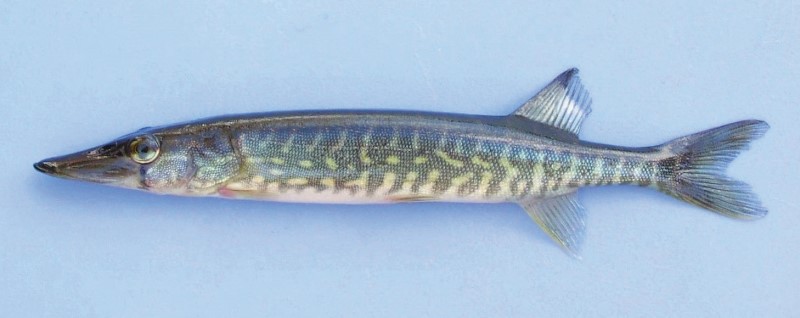Chain Pickerel (Esox niger) - Native

A 17-inch adult chain pickerel displays the characteristic bright yellow color and distinctive chain-like markings.
Identification. Dark chain-like markings on side. Opercle and cheek fully scaled. Dark bar extends vertically downward (or only slightly backward) from eye. Snout longer than redfin pickerel (distance from tip of snout to beginning of eye about same as distance from back of eye to back edge of opercle). Dorsal and tail fins without dark markings. Dark olive to brown on back fading to yellow on sides and white on belly. Pectoral, pelvic and anal fins may be slightly reddish. Markings on juveniles vary with age, but typically appear as light wavy lines and/or spots on a dark background.

This 9-inch subadult chain pickerel is just beginning to develop the chain-like markings of the adult.
Size. Commonly 10 to 18 inches. State survey max. size 27.5 inches. Conn. State Record 8.6 pounds, 29.5 inches. World Record 9.4 pounds, 31 inches.
Distribution. Eastern coastal United States from Maine to Florida and west to Missouri and Louisiana. Found in almost all lakes and ponds and in most medium to large streams in Connecticut, where they range from rare to common in abundance. For unclear reasons, chain pickerel are less common in streams west of the Connecticut River. A similar east/west pattern is present in Massachusetts.

All maps created in 2009. See CT DEEP Fish Community Data for updated distributions.
Habits. Prefer quiet, vegetated areas of small shallow ponds to large lakes, and in all but the smallest of streams. Similar to northern pike, they most often feed by ambushing fish, but may also forage for invertebrates, such as crayfish. Pickerel can readily be caught on a variety of lures and baits.

A 2.4-inch juvenile chain pickerel.
Comments. The chain pickerel is Connecticut’s largest native freshwater predatory fish. Before the introduction of bass, it was the top predator in the state’s lakes and ponds. Similar to pike, they feed actively throughout the winter and are popular with ice anglers. Large pickerel are most common in lightly-fished waters. Pickerel populations have decreased in lakes where inshore vegetation that is required for spawning and rearing of young has been reduced by practices such as winter drawdown.
Text and images adapted from Jacobs, R. P., O'Donnell, E. B., and Connecticut DEEP. (2009). A Pictorial Guide to Freshwater Fishes of Connecticut. Hartford, CT. Available for purchase at the DEEP Store.

